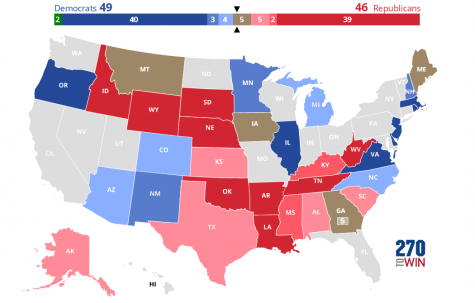Election Night 2020: A Guide
November 3, 2020
For the 59th time in American history, voters will decide who they want as their President of the United States for the next four years: Former Vice President Joseph R. Biden Jr. or President Donald J. Trump. Additionally, thirty-five Senate seats will be in play, as well as all 435 seats in the House of Representatives. Flipping on your television to the news or opening Twitter will likely provide you with plenty of information that is irrelevant to determining what actually matters–so here’s what to actually watch for on Election Night.
The 59th Quadrennial Presidential Election
Ever since Former Secretary of State Hillary Clinton’s shocking loss in the 2016 Presidential Election, the Democratic Party has worked to take back the White House from Mr. Trump and the Republicans. Following the 2018 midterms, which saw fierce infighting between the progressive and moderate wings, the party lacked a true standard-bearer, which led to the largest and most diverse field of presidential candidates in history. Even so, the Democrats eventually fixed its gaze on the man they’d known the longest–the two-term Vice President and seven-term Senator from Delaware. For the 77-year-old Mr. Biden, this was truly his moment. His first two runs for the White House–in 1988 and 2008–failed to gain traction amongst primary voters, but this time his message of “Restoring the Soul of America” connected with voters (despite several early stumbles) and allowed him to coalesce the moderate wing of the party behind him before scoring major victories over his progressive rival Senator Bernie Sanders on Super Tuesday.
Despite polling showing Mr. Biden holding large leads over the incumbent Mr. Trump, Democrats remain haunted by the ghosts of 2016, when all polling pointed to a victory for Ms. Clinton. However, Mr. Trump edged out victories in the traditionally Democratic “blue wall” of Michigan, Pennsylvania, and Wisconsin–which propelled him to the electoral college win. Those three states remain major battlegrounds in this election, and if any candidate carries all three of them, they will surely enjoy January 20th. However, due to the increases in mail-in balloting, there is a decent chance that these states remain uncalled on Election Night. Therefore, if you want a good idea of how the race is going, you may have to look elsewhere.
Even 20 years later, Florida elections remain infamous for “hanging chads” and the 537 infamous votes that handed the 2000 election to George W. Bush. Despite their history, however, Florida has long been a leader in mail-in-voting. Their robust counting system makes it very likely that it will be called on election night, and there is a lot we can extrapolate from its results.
Florida is essential to the Trump map–without it, Mr. Biden will need just one other swing state (like Michigan) to get over the magic number of 270 Electoral votes. Although Mr. Trump carried the state by a 1.2% margin over Ms. Clinton in 2016, his path to victory will look very different this time around. Ms. Clinton’s ground game in the state was perhaps her best anywhere and was widely successful with its outreach towards Hispanics and Cuban-Americans in Miami-Dade County. Although Cuban-Americans are a core part of the Republican coalition in the state, Mr. Trump eschewed outreach to those communities the last cycle–a mistake he has not repeated this time. Cuban-Americans no longer feel the sting of the divisive primary campaign between Mr. Trump and Florida Senator Marco Rubio (himself a Cuban-American) and have rallied back to the Republican Party. Mr. Biden will unquestionably carry Miami-Dade county but do not expect him to put up the numbers that Ms. Clinton, who won it by nearly 30 points, did. If he just wins by 15-20 points, he will be in a fine position because of his likely improvements in Central Florida.
Sumter County is part of the state that you should keep your eye on this election and could be a potential canary in the coal mine for Mr. Trump. The home of the massive retirement community known as The Villages, Sumter is a heavily Republican county. However, with Mr. Biden improving dramatically in the polls versus Ms. Clinton among senior voters and nearly all of the residents voting early and by mail, it will likely tell us about Mr. Biden’s standing among this crucial demographic. You will likely see results come in early in this county and if Mr. Trump only receives 60-61% of the vote, it may be a short Election Night (he carried the county 68-29 in 2016). Polls have shown that Mr. Trump is hemorrhaging support among seniors, who voted for him by a 53-44 margin nationwide in 2016. Some polls in mid-October show Mr. Biden with double-digit leads in this category of voters, who are overwhelmingly concerned with COVID-19 and have a negative view of Mr. Trump’s handling of the crisis. If Mr. Biden can cut into Mr. Trump’s margins in retirement communities in Central Florida, it may be just enough to put him over the top and score a decisive victory in the Sunshine State.
Rapidly changing demographics in the so-called Sun Belt have led Democrats to set their sights on the two traditionally Republican states of Arizona and Texas that they believe can swing towards Mr. Biden this cycle. Arizona, the old home to conservative titans like Senators John McCain and Barry Goldwater, elected a Democratic Senator in 2018 for the first time in 30 years and the Biden campaign is investing serious money with the hopes of carrying the state’s 11 electoral votes. For this state, which has laws allowing the early counting of mail-in ballots and will likely be called on Election Night, Maricopa County is the key. The county, which houses Phoenix, its surrounding suburbs, and 62% of the state’s population, is emblematic of Arizona’s leftward shift. The county voted for Mr. Trump by three points in 2016 and Mitt Romney by 11 points in 2012 and will have to swing to Mr. Biden if he wants to carry the state. His coalition there includes the suburban women that delivered the Democrats the House in the 2018 midterms, a young Hispanic population that has exploded in size, and traditional conservatives that remain skeptical of the President.
Texas has also seen a large spike in its Hispanic population, as well as liberals moving to the state from California and New York. The trends in Texas will almost certainly mean Democrats will increasingly win statewide elections, but it is unclear if it has yet reached the tipping point that would deliver its 38 electoral votes to a Democrat for the first time since 1976.
With all of that being said, the 2020 Presidential Election will ultimately rest on the Upper Midwest and the three states of Michigan, Pennsylvania, and Wisconsin that Mr. Trump carried in 2016 by a combined 70,000 votes. Most forecasters expect these states–and Pennsylvania in particular–to be the tipping points of the election. The tipping point, which was Pennsylvania four years ago, is the state that hands the winner their 270th electoral vote. That does not mean that they will necessarily be the closest state, but it means that they will be the deciders of the election.
Mr. Trump’s shocking upset in the Rust Belt four years ago was largely due to his ability to tap into resentment towards the status quo harbored by white, non-college-educated voters who overwhelmingly turned out to the polls to cast their ballot for the “outsider.” Democrats hope that Mr. Biden, who has spent his career touting his blue-collar roots and working-class home of Scranton, PA, can bring these blue-collar workers–once reliable Democrats–back into his column this time. The county to keep your eye on for this is Erie County, PA. Located in Northwest Pennsylvania, the county was once solidly blue due to its history as a union district that built cars and packaged meat. As those jobs left, the voters left the Democrats and gave Mr. Trump a narrow 2-point margin in the county. Mr. Biden has spent his time on the road in communities like Erie, touting his plans to “Build Back Better” and hopes to rebuild the traditional Democratic coalition of working-class voters.
However, if blue-collar voters are trending Republican, suburbanites are going the other way. Once a large part of the Republican base, affluent, educated, white suburban voters have soured on the GOP’s rhetoric and policy and shifted towards the Democrats. The DNC hopes that, should Mr. Biden fail to pick up working-class voters, he can offset those losses and then some in the suburbs. A bellwether to look for here is Kent County, MI. The home of Republican President Gerald Ford and the DeVos family, Kent County–which encapsulates Grand Rapids and its surrounding area–symbolizes a shifting suburbia. Mr. Trump ran behind Mr. Romney’s margin in the county and Democratic Governor Gretchen Whitmer carried the county in 2018 and Mr. Biden hopes to do the same this year as the professional class increasingly joins the base of the Democratic Party.
The 2020 Senate Elections

The wave election of 2018 that led to a 41-seat swing in the US House of Representatives towards the Democratic Party met a brick wall in the statewide Senate races during the same year. A historically unfavorable map towards Democrats put them on the defensive in traditional Republican strongholds and, despite major victories by Joe Manchin and Jon Tester, Midwest Democrats like Claire McCaskill, Joe Donnelly, and Heidi Heitkamp were routed by challengers, expanding the Republican majority in the chamber by a net gain of two seats–giving them a 53-47 advantage heading into the 2020 campaign. But this time the roles are reversed. Republicans will be forced to defend 23 seats versus the 12 Democrats hope to hold. Since the Vice-President breaks a tie in the Senate, Democrats will need to net four seats or three seats and the Presidency to retake the chamber, which they have not done in six years.
Alabama
Democrat Doug Jones’ upset victory in a 2017 special election in one of the most Republican states in the country has made election forecasters wonder whether he can catch lightning in a bottle once again as he seeks a full six-year term in his own right. Despite being a political neophyte, Mr. Jones’ opponent Tommy Tuberville is well known throughout the state as the former football coach at Auburn University. He defeated former Attorney General and Senator Jeff Sessions in a contentious Republican primary election by aligning himself closely to President Trump, who endorsed the coach just before the primary. Mr. Tuberville is widely considered to be a stronger candidate than the scandal-plagued Judge Roy Moore, who Mr. Jones defeated by just 0.6% in 2017, and most polls show Mr. Tuberville enjoying vast double-digit leads.
Cook Political Report Rating: Leans Republican (Flip)
Arizona
Despite her defeat in the 2018 Arizona Senate election, Republican Governor Doug Ducey appointed Martha McSally to fill the other Senate seat and she is now trying to avoid losing two statewide campaigns in as many years. But facing perhaps the strongest Democratic challenger seeking a Senate seat this cycle, she faces an uphill battle. With just his credentials as a former Navy pilot and NASA astronaut, Mark Kelly would be a formidable opponent to Ms. McSally. But excludes his greatest asset–his wife. Former Congresswoman Gabrielle Giffords (D-AZ) was once considered a rising star in the party, until an attempted assassination nine years ago abruptly ended her career in public service and left her partially incapacitated. She has become an outspoken advocate against gun violence and is central to the Kelly campaign’s message of unity and hope. Mr. Kelly leads in most polling by an average of 5-15 points and is essential to Democrats goals of retaking the Senate.
Cook Political Report Rating: Leans Democratic (Flip)
Colorado
After his quixotic Presidential bid fizzled out last fall, the Democratic Senatorial Campaign Committee made a concerted effort to recruit popular Former Governor John Hickenlooper to challenge Senator Cory Gardner, who is perhaps the most vulnerable Republican up for re-election in 2020. Even though he was seen as a heavyweight candidate, Mr. Hickenlooper has stumbled at times during the campaign, from the Democratic primary, where he tried to avoid being outflanked on the left while still maintaining his image as a moderate, to ethics issues that have swirled around some of his expenses as Governor. Still, Mr. Gardner remains unpopular in the increasingly Democratic state and with Mr. Biden almost guaranteed to carry Colorado in the Presidential Election, it seems unlikely that Mr. Gardner can win over enough Biden voters to secure another term.
Cook Political Report Rating: Leans Democratic (Flip)
Georgia
This year Republicans have to play defense on two Senate seats in a state that is increasingly Democratic. Senator David Perdue is seeking another six-year term against 33-year old Jon Ossoff, who narrowly lost a nationally watched House race three years ago. Mr. Ossoff has far outraised his rival and appears to be closing the gap in recent polls, especially after a recent incident where Mr. Perdue mocked the name of Democratic Vice-Presidential nominee Kamala Harris in a move that was widely seen as racist. Following the resignation of elderly Senator Johnny Isakson, Republican Governor Brian Kemp appointed Atlanta businesswoman Kelly Loeffler to finish his term and she will attempt to hold the seat in a special election this fall, but faces challenges from her right and left flanks. The White House did not attempt to hide their displeasure with Ms. Loeffler’s appointment, preferring instead that Mr. Kemp would’ve appointed Congressman Doug Collins, a former pastor and one of Mr. Trump’s most vocal supporters during the impeachment process. Mr. Collins got in the race and cast himself as a conservative populist, forcing Ms. Loeffler to make a hard turn right, even going so far as to declare herself in an ad as “more conservative than Attila the Hun.” The special election is a “jungle primary” where all candidates (there are more than 20) will be placed on the ballot and, should no candidate reach 50%–which is extremely likely–the top two vote getters will advance to a runoff election. Democrats have largely consolidated around the Reverend Raphael Warnock, the minister at Ebenezer Baptist Church. Mr. Warnock is virtually guaranteed to advance in the primary and will face either Mr. Collins or Ms. Loeffler (they are running neck and neck in all polls) in January.
Cook Political Report Rating
Georgia Regular: Tossup
Georgia Special: Tossup
Maine
Senator Susan Collins, who won her last election with 68% of the vote, heads home this year in the closest race of her life and as the only Congressional Republican from New England. Ms. Collins, who has long cast herself as a moderate, became a target for liberals after her 2018 vote for Supreme Court nominee Brett Kavanaugh and her tendency to chastise President Trump only to vote for his agenda. In 2020, she faces a well-financed and well-known challenger in Sara Gideon, the former Speaker of the Maine House of Representatives. Ms. Gideon raised nearly $40 million in the fundraising quarter that ended on September 30 and narrowly leads Ms. Collins in most polls.
Cook Political Report Rating: Tossup
Montana
The fact that Montana has a close Senate race this cycle is a testament to Democrats’ recruitment successes. After months of saying he would not seek the Senate seat held by Republican Steve Daines, popular Democratic Governor Steve Bullock filed at the last minute for the race–immediately turning it into a battleground. Although Montana will likely be in Mr. Trump’s column this election, residents of the state pride themselves on an independent streak that saw Mr. Bullock win two terms as Governor and Democrat Jon Tester win reelection to Montana’s other Senate seat in 2018. Polls have Mr. Daines and Mr. Bullock in a tight race without a clear favorite.
Cook Political Report Rating: Tossup
North Carolina
The Tar Heel State is seen by Republicans and Democrats alike as the state that will likely decide control of the Senate and the race there has been shaken up by both candidates in recent weeks. Senator Thom Tillis, a Republican, has grown increasingly unpopular with centrists in the state due to his continued support of the President and tested positive for COVID-19 after attending the introduction of Amy Coney Barrett in the Rose Garden that became a super-spreader event. Mr. Tillis’ opponent is 47-year old former State Senator and Iraq War veteran Cal Cunningham, who was enjoying 6-8 point leads in the polls. However, at the same time that Mr. Tillis contracted the virus, sexual–though PG– text messages between Mr. Cunningham and a campaign pollster were leaked to the media. Recent data has shown that this scandal has harmed Mr. Cunningham’s favorability ratings, but not his standing in the polls. He will attempt to hold on to his lead in the race that may give Democrats control of the Senate.
Cook Political Report Rating: Tossup
South Carolina
The Palmetto State has become one of the fiercest Senate battlegrounds of 2020 as South Carolina Democratic Chairman Jamie Harrison has closed the gap on Senator Lindsey Graham, a hated figure among liberals. Mr. Graham was once one of President Trump’s most vocal critics within the GOP but has quickly shifted to being one of his fiercest allies. Mr. Graham is the Chairman of the Senate Judiciary Committee and shepherded Justice Kavanaugh to the bench in 2018. And, after declaring that “you could use my words against me” regarding his opposition to the filling of a Supreme Court seat in an election year, Mr. Graham reversed course and has become a strong fighter for Amy Coney Barrett. Mr. Harrison nearly doubled the fundraising record for Senate candidates in one quarter when he raised an astonishing $57 million in the third quarter of this year. Mr. Graham raised $28 million during that same time, a GOP record, highlighting the premium that both parties are placing on this state. Polls show a tight race with Mr. Graham maintaining a small advantage.
Cook Political Report Rating: Tossup
The House of Representatives
After a 41-seat swing handed Democrats the US House of Representatives in 2018, Republicans have been vying to retake the chamber, but it seems unlikely that it will happen this year. Not only will Republicans not win back the House, they admit privately that they will likely lose even more seats. Following the Supreme Court redrawing districts in North Carolina, Democrats will handily pick up the North Carolina 2nd and 6th. Additionally, the open seat in the Georgia 7th–which was the closest race in 2018 as incumbent Rob Woodall won by only 433 votes–seems likely to also be picked up by the Democrats as Mr. Woodall is retiring. The Texas 23rd, represented by a retiring moderate Republican who barely won re-election last time, will likely endure a similar fate. Democrats are also targeting suburban districts in Indiana, Michigan, and Missouri that can very plausibly swing blue this election.
On the other side, Republicans are struggling to go on the offensive as there are no districts that are guaranteed to flip their way. Their best chance may be the Minnesota 7th, a district that Mr. Trump won by 31 points in 2016 and is represented by conservative Democrat Collin Peterson–the chairman of the House Committee on Agriculture. Republicans recruited a heavyweight candidate, Former Lt. Governor Michelle Fischbach, to challenge Mr. Peterson and both parties acknowledge that it will be a tight race. They are also targeting several traditionally Republican districts that swung Democratic last cycle including Oklahoma’s 5th, New Mexico’s 2nd, California’s 21st, and New York’s 11th. Some of these freshman Democrats may face an uphill battle to retain their seats.







